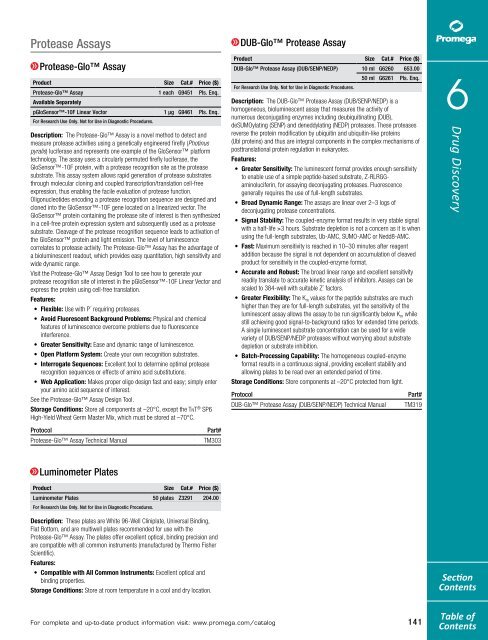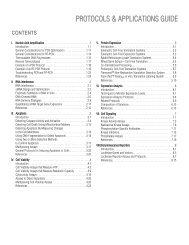2012 Promega catalogue
2012 Promega catalogue
2012 Promega catalogue
You also want an ePaper? Increase the reach of your titles
YUMPU automatically turns print PDFs into web optimized ePapers that Google loves.
Cell Signaling<br />
Protease Assays<br />
Protease-Glo Assay<br />
Product Size Cat.# Price ($)<br />
Protease-Glo Assay 1 each G9451 Pls. Enq.<br />
Available Separately<br />
pGloSensor-10F Linear Vector 1 µg G9461 Pls. Enq.<br />
For Research Use Only. Not for Use in Diagnostic Procedures.<br />
Description: The Protease-Glo Assay is a novel method to detect and<br />
measure protease activities using a genetically engineered firefly (Photinus<br />
pyralis) luciferase and represents one example of the GloSensor platform<br />
technology. The assay uses a circularly permuted firefly luciferase, the<br />
GloSensor-10F protein, with a protease recognition site as the protease<br />
substrate. This assay system allows rapid generation of protease substrates<br />
through molecular cloning and coupled transcription/translation cell-free<br />
expression, thus enabling the facile evaluation of protease function.<br />
Oligonucleotides encoding a protease recognition sequence are designed and<br />
cloned into the GloSensor-10F gene located on a linearized vector. The<br />
GloSensor protein containing the protease site of interest is then synthesized<br />
in a cell-free protein expression system and subsequently used as a protease<br />
substrate. Cleavage of the protease recognition sequence leads to activation of<br />
the GloSensor protein and light emission. The level of luminescence<br />
correlates to protease activity. The Protease-Glo Assay has the advantage of<br />
a bioluminescent readout, which provides easy quantitation, high sensitivity and<br />
wide dynamic range.<br />
Visit the Protease-Glo Assay Design Tool to see how to generate your<br />
protease recognition site of interest in the pGloSensor-10F Linear Vector and<br />
express the protein using cell-free translation.<br />
Features:<br />
• Flexible: Use with P´ requiring proteases.<br />
• Avoid Fluorescent Background Problems: Physical and chemical<br />
features of luminescence overcome problems due to fluorescence<br />
interference.<br />
• Greater Sensitivity: Ease and dynamic range of luminescence.<br />
• Open Platform System: Create your own recognition substrates.<br />
• Interrogate Sequences: Excellent tool to determine optimal protease<br />
recognition sequences or effects of amino acid substitutions.<br />
• Web Application: Makes proper oligo design fast and easy; simply enter<br />
your amino acid sequence of interest.<br />
See the Protease-Glo Assay Design Tool.<br />
Storage Conditions: Store all components at –20°C, except the TnT ® SP6<br />
High-Yield Wheat Germ Master Mix, which must be stored at –70°C.<br />
Protocol Part#<br />
Protease-Glo Assay Technical Manual TM303<br />
Luminometer Plates<br />
Product Size Cat.# Price ($)<br />
Luminometer Plates 50 plates Z3291 204.00<br />
For Research Use Only. Not for Use in Diagnostic Procedures.<br />
Description: These plates are White 96-Well Cliniplate, Universal Binding,<br />
Flat Bottom, and are multiwell plates recommended for use with the<br />
Protease-Glo Assay. The plates offer excellent optical, binding precision and<br />
are compatible with all common instruments (manufactured by Thermo Fisher<br />
Scientific).<br />
Features:<br />
• Compatible with All Common Instruments: Excellent optical and<br />
binding properties.<br />
Storage Conditions: Store at room temperature in a cool and dry location.<br />
For complete and up-to-date product information visit: www.promega.com/catalog<br />
DUB-Glo Protease Assay<br />
Product Size Cat.# Price ($)<br />
DUB-Glo Protease Assay (DUB/SENP/NEDP) 10 ml G6260 653.00<br />
For Research Use Only. Not for Use in Diagnostic Procedures.<br />
50 ml G6261 Pls. Enq.<br />
Description: The DUB-Glo Protease Assay (DUB/SENP/NEDP) is a<br />
homogeneous, bioluminescent assay that measures the activity of<br />
numerous deconjugating enzymes including deubiquitinating (DUB),<br />
deSUMOylating (SENP) and deneddylating (NEDP) proteases. These proteases<br />
reverse the protein modification by ubiquitin and ubiquitin-like proteins<br />
(Ubl proteins) and thus are integral components in the complex mechanisms of<br />
posttranslational protein regulation in eukaryotes.<br />
Features:<br />
• Greater Sensitivity: The luminescent format provides enough sensitivity<br />
to enable use of a simple peptide-based substrate, Z-RLRGG-<br />
aminoluciferin, for assaying deconjugating proteases. Fluorescence<br />
generally requires the use of full-length substrates.<br />
• Broad Dynamic Range: The assays are linear over 2–3 logs of<br />
deconjugating protease concentrations.<br />
• Signal Stability: The coupled-enzyme format results in very stable signal<br />
with a half-life >3 hours. Substrate depletion is not a concern as it is when<br />
using the full-length substrates, Ub-AMC, SUMO-AMC or Nedd8-AMC.<br />
• Fast: Maximum sensitivity is reached in 10–30 minutes after reagent<br />
addition because the signal is not dependent on accumulation of cleaved<br />
product for sensitivity in the coupled-enzyme format.<br />
• Accurate and Robust: The broad linear range and excellent sensitivity<br />
readily translate to accurate kinetic analysis of inhibitors. Assays can be<br />
scaled to 384-well with suitable Z´ factors.<br />
• Greater Flexibility: The K m values for the peptide substrates are much<br />
higher than they are for full-length substrates, yet the sensitivity of the<br />
luminescent assay allows the assay to be run significantly below K m while<br />
still achieving good signal-to-background ratios for extended time periods.<br />
A single luminescent substrate concentration can be used for a wide<br />
variety of DUB/SENP/NEDP proteases without worrying about substrate<br />
depletion or substrate inhibition.<br />
• Batch-Processing Capability: The homogeneous coupled-enzyme<br />
format results in a continuous signal, providing excellent stability and<br />
allowing plates to be read over an extended period of time.<br />
Storage Conditions: Store components at –20°C protected from light.<br />
Protocol Part#<br />
DUB-Glo Protease Assay (DUB/SENP/NEDP) Technical Manual TM319<br />
141<br />
6<br />
Drug Discovery<br />
Section<br />
Contents<br />
Table of<br />
Contents
















